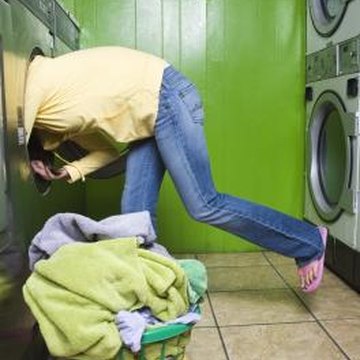
Install your own washer and dryer to avoid the laundromat.
Moving
into your new home may finally allow you to purchase a new washer and
dryer, so you do not have to lug your laundry between the laundromat and
home. For the first-time home buyer, installing a standard washer and
dryer may be a bit intimidating, and you might consider paying for
professional installation. Rather than pay a professional, keep that
installation money in your pocket and install your appliances yourself
with just a few appliance accessories and a few tools.
1
Insert hose washers into the ends of the hot and cold water supply hoses. Screw the hoses onto the water supply valves in the laundry area wall. Place washers in the opposite ends of the hoses and attach them to the inlet valve connectors on the back of the washer. Ensure the hot water line connects to the hot water inlet valve.2
Thread the washer drain hose through a U-shaped drain hose holder, which will keep the drain hose from accidentally slipping from the drain. Insert the drain hose and holder into the drain pipe.3
Plug the washer into the wall outlet. Turn on the washer’s water supply valves.4
Push the washer into its installation location, and then place a level across the top of the washer. Use an adjustable wrench to turn the front leveling feet clockwise or counterclockwise to ensure the washer is level from left to right.5
Tilt the washer toward you, so the rear feet lift off the floor about 3 inches. Gently place the washer back down on the floor. This automatically adjusts the self-leveling rear legs of the washer.6
Check your dryer's power cord to ensure the outlet and the plug match. Dryer cords have either four prongs or three prongs. If the plug does not match the outlet, change the power cord.7
Remove the power cord access plate screws to take the plate off the back of the dryer. Loosen the screws holding the power cord to the power block. Loosen the two screws on the exterior of the strain relief connector securing the power cord to the dryer body. Pull the original cord from the dryer.8
Thread the end of the new dryer cord through the strain relief connector. Slide the white, or center, power cord wire beneath the center screw on the power block. Slide the remaining black and red wires beneath the right and left screws; it doesn't matter which black or red colored wire attaches to the right or left screw, but the white wire must always attach to the center screw. If your power cord has a green wire, slide it beneath the green screw along the edge of the block opening.9
Tighten all the screws on the block and the two screws on the strain relief connector. Replace the power cord access panel.10
Slip a dryer vent clamp over one end of a length of flexible dryer duct. Slide the vent over the dryer vent outlet. Tighten the screw on the dryer vent clamp. Use another vent clamp to secure the dryer vent over the vent opening in the wall.11
Push the dryer into its installation location, taking care that the vent isn’t kinked or bent, as this could cause a dryer to overheat. Shorten the vent with utility shears or rearrange it to remove the kinks if necessary.12
Plug the dryer’s power cord into the dryer wall outlet. Use the same steps to level the dryer as you did with the washer.Things You Will Need
- Hose washers
- Hot and cold washer supply hoses
- Drain hose holder
- Level
- Adjustable wrench
- Screwdriver
- Three- or four-pronged dryer cord
- Dryer vent clamps
- Dryer vent hose
- Utility shears
Tip
- If you live in a mobile home, or your home was built after January 1, 1996, the National Electrical Code requires the installation of a four-prong grounded dryer outlet. Any homes, with the exception of mobile homes, built prior to this date, have three-prong or four-prong outlets installed, depending on the original builder’s requirements. The NEC did not require older homes to convert to a grounded outlet.
Warning
- Do not attempt to change the outlet to fit the dryer cord, as this could void your homeowner’s warranty. Should a fire incur as the result of changing the dryer out, your homeowner’s insurance could deny your claim.

No comments:
Post a Comment